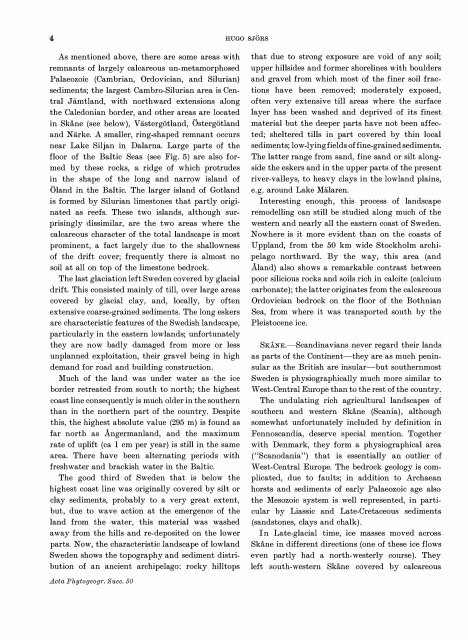Create successful ePaper yourself
Turn your PDF publications into a flip-book with our unique Google optimized e-Paper software.
4 HUGO SJORSAs mentioned above, there are some areas withremnants of largely calcareous un-metamorphosedPalaeozoic (Cambrian, Ordovician, and Silurian)sediments; the largest Cambro-Silurian area is CentralJamtland, with northward extensions alongthe Caledonian border, and other areas are locatedin Skane (see below), Vastergotland, Ostergotlandand Narke. A smaller, ring-shaped remnant occursnear Lake Siljan in Dalarna. Large parts of thefloor of the Baltic Seas (see Fig. 5) are also formedby these rocks, a ridge of which protrudesin the shape of the long and narrow island ofOland in the Baltic. The larger island of Gotlandis formed by Silurian limestones that partly originatedas reefs. These two islands, although surprisinglydissimilar, are the two areas where thecalcareous character of the total lands ea pe is mostprominent, a fact largely due to the shallownessof the drift cover; frequently there is almost nosoil at all on top of the limestone bedrock.The last glaciation left Sweden covered by glacialdrift. This consisted mainly of till, over large areascovered by glacial clay, and, locally, by oftenextensive coarse-grained sediments. The long eskersare characteristic features of the Swedish landscape,particularly in the eastern lowlands; unfortunatelythey are now badly damaged from more or lessunplanned exploitation, their gravel being in highdemand for road and building construction.Much of the land was under water as the iceborder retreated from south to north; the highestcoast line consequently is much older in the southernthan in the northern part of the country. Despitethis, the highest absolute value (295 m) is found asfar north as Angermanland, and the maximumrate of uplift (ea l cm per year) is still in the samearea. There have been alternating periods withfreshwater and brackish water in the Baltic.The good third of Sweden that is below thehighest coast line was originally covered by silt orclay sediments, probably to a very great extent,but, due to wave action at the emergence of theland· from the .water, . this material was washedaway from the hills and re-deposited on the lowerparts. Now, the characteristic landscape of lowlandSweden shows the topography and sediment distributionof an ancient archipelago: rocky hilltopsthat due to strong exposure are void of any soil;upper hillsides and former shorelines with bouldersand gravel from which most of the finer soil fractionshave been removed; moderately exposed,often very extensive till areas where the surfacelayer has been washed and deprived of its finestmaterial but the deeper parts have not been affected;sheltered tills in part covered by thin localsediments; low -lying fields of fine-grained sediments.The latter range from sand, fine sand or silt alongsidethe eskers and in the upper parts of the presentriver-valleys, to heavy clays in the lowland plains,e.g. around Lake Malaren.Interesting enough, this process of landscaperemodelling can still be studied along much of thewestern and nearly all the eastern coast of Sweden.Nowhere is it more evident than on the coasts ofUppland, from the 50 km wide Stockholm archipelagonorthward. By the way, this area (andAland) also shows a remarkable contrast betweenpoor silicious rocks and soils rich in calcite (calciumcarbonate); the latter originates from the calcareousOrdovician bedrock on the floor of the BothnianSea, from where it was transported south by thePleistocene ice.SKANE. -Scandina vians never regard their landsas parts of the Continent-they are as much peninsularas the British are insular-but southernmostSweden is physiographically much more similar toWest-Central Europe than to the rest of the country.The undulating rich agricultural landscapes ofsouthern and western Skane (Scania), althoughsomewhat unfortunately included by definition inFennoscandia, deserve special mention. Togetherwith Denmark, they form a physiographical area("Scanodania") that is essentially an outlier ofWest-Central Europe. The bedrock geology is complicated,due to faults; in addition to Archaeanhorsts and sediments of early Palaeozoic age alsothe Mesozoic system is well represented, in particularby Liassic and Late-Cretaceous sediments(sandstones, clays and chalk).In Late-glacial time, ice masses moved acrossSkane in different directions (one of these ice flowseven partly had a north-westerly course). Theyleft south-western Skane covered by calcareous.Acta Phytogeogr. Suec. 50
















